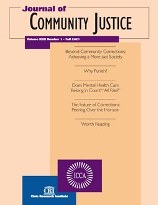Complete Issue
Author: Don Evans.
Source: Volume 17, Number 02, Winter 2008 , pp.1-32(32)

< previous article |return to table of contents
Abstract:
At the ICCA Annual Research Conference held in San Diego, California, October 28–31, 2007, Senior Judge Arthur L. Burnett, Sr., the executive director of the National African-American Drug Policy Coalition, delivered a paper, reprinted here, on the subject of “Removing Barriers to Employment for People with Criminal Records Through Policy and Advocacy Efforts.” In his paper, Burnett notes that we must change our attitudes toward those persons convicted of criminal offenses and that society can no longer afford to simply release offenders from our institutions with $50 or $200 and tell them to “go and sin no more!” There must be reality to the idea of second chances, and Burnett argues that our past policies have promoted and encouraged recidivism. He wants to see changes brought about through legislative action and advocacy activity that removes barriers to an offender’s successful reentry. Burnett discusses a number of ideas that could or should shape future policy and legislative efforts. For example, where there is an arrest that does not proceed to a charge, this should be expunged and thus cease to be a negative factor in seeking employment. Also, even after conviction and a passage of a reasonable crime-free period, there should be a process for sealing the record and thus improving employment opportunities. Burnett is pleased that in recent years, there has been an effort to remove barriers to employment and housing. Homelessness and unemployment are the twins encouraging reoffending and keeping some offenders from a realistic second chance. The article concludes with 14 recommendations that could commence a change effort in regard to the problem of criminal record discrimination and rejection of the offender. They are worthy of study and, if in agreement, advocacy. There is considerable evidence that untreated substance abuse problems increase the likelihood that an offender will reoffend—therefore the need for appropriate follow-up and continuity of programming when an offender is released to community supervision. Michael Crowley, board member of the National Parole Board of Canada, Ontario Region, discusses the role of the parole board member in his or her decision making regarding the release of offenders with substance abuse problems. Crowley walks the reader through the process of a parole board member’s preparation, analysis, and decision regarding offenders and the role substance abuse plays in whether or not the offender is considered to be a manageable risk for community supervision. In implementing effective practices, there are a number of issues and problems that emerge. In the next article, Ray Banks, chief operating officer for Turning Point of Central California, discusses the problems that confusion about the meaning of “risk” can create in promoting and implementing a program of correctional change. He provides three possible definitions of risk that are held by various actors in the justice system and the public. Getting a clear definition of what we mean by risk in terms of the “what works” research is important, but even more important is that it must be conveyed to a larger public if we are to avoid the confusion. Banks also examines the concept of reaching one’s level of competency, the Peter Principle! Banks applies this point of view to programs rather than individuals. He uses this concept to discuss difficulties in programming and the use of scare resources. It is a thought-provoking and prodding approach! Alvin W. Cohn, D.Crim., in his article, stresses the importance of management leadership in the field of community corrections. He discusses the problem that moral panics create for management and the impact these panics have on legislators and political actors and subsequently on community corrections. Dr. Cohn also addresses the issue of competency and the role of managers as change agents. To be effective agents of change, managers must understand what is meant by management control processes, better planning, and an understanding of the ethos—that is, the culture and values that are expressed by the organization they seek to manage. Cohn would like to seek a greater use of partnerships, and this requires strong, competent manager-leaders who develop appropriate protocols and agreements between the partners. One particular partnership he would like to see forged is with colleges and universities. This would be especially helpful in evaluation of correctional programs. The manager-leader needs to take a lead in forming a close working relationship with colleges, universities, and research institutes to assist in the development of an evaluative framework and the carrying out of the evaluation process. The final article in this issue of JCC is by Larry M. Fehr, senior vice president, Pioneer Human Services (PHS), in Seattle, Washington. His overview of the services offered by PHS and their efforts to provide programs that will change lives is a helpful look at a particular model of business organization and management. The essence of the PHS approach is to operate a number of businesses in which clients are trained and employed. Classroom instruction and on-the-job training are provided to clients in a supportive environment. This social enterprise model becomes the “means” to achieve the “end” of client success.Keywords:
Affiliations:
1: Journal Editor.